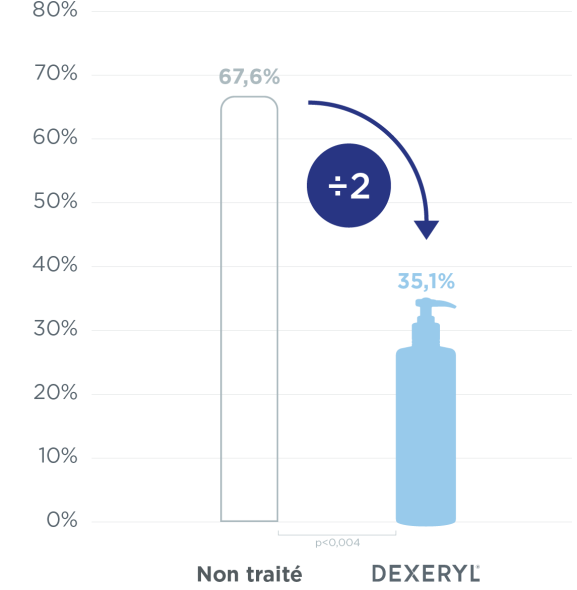DEXERYL Emollient Cream: AN EFFECTIVE TREATMENT for the symptoms of dry skin conditions with atopic dermatitis
DEXERYL Emollient Cream
Statistically significant effectiveness proven in clinical studies on over 1000 patients. These studies were done against a placebo or comparator, providing the highest level of scientific evidence.

DEXERYL Emollient Cream has been shown in several studies to be effective against the symptoms of dry skin conditions in the context of atopic dermatitis.
First clinical study
This first study demonstrates the benefits of using DEXERYL Emollient Cream in the treatment of dry skin conditions in the context of mild to moderate atopic dermatitis in children.
With regular and prolonged application during phases of remission, DEXERYL Emollient Cream makes flare-ups less frequent1
DEXERYL Emollient Cream significantly reduces and delays the number of flare-ups compared to untreated patients1

- -77.5%
dry skin at 12 weeks according to parents¹
- 2X
fewer patients used corticosteroids²
1- Tiplica G.S. et al. The regular use of an emollient improves symptoms of atopic dermatitis in children: a randomised controlled study. JEADV 2018
2- Tiplica G.S. et al. Prevention of flares in children with atopic dermatitis with regular use of an emollient containing glycerol and paraffin: a randomized controlled study. Pediatric Dermatology 2017
METHODOLOGY: First clinical study
Objective
To demonstrate the benefits of using Dexeryl Emollient Cream in the treatment of mild to moderate atopic dermatitis in children, by assessing the ability of Dexeryl to prevent flare-ups and reduce the use of corticosteroids.
Study
International, multicentre, randomised, parallel, open-label.
Population
335 children aged 2 to 6 years with mild to moderate atopic dermatitis, recruited during a flare-up and treated with a strong topical corticosteroid and finally randomised once the lesions had cleared up (111 treated with Dexeryl Emollient Cream, 116 treated with the reference emollient and 108 without emollient treatment).
Dosage
Dexeryl Emollient Cream twice a day on the whole body, reference emollient three times a day on the affected areas of the body.
Duration
12 weeks (intermediate evaluations after 4 and 8 weeks).
Primary evaluation criteria
Percentage of patients with at least one flare-up after 12 weeks.
Secondary evaluation criteria
Time to first flare-up, time to complete remission, number of flare-ups, percentage of patients requiring corticosteroids or immunosuppressants at weeks 4, 8 and 12, corticosteroid use.
Tolerance
Good tolerance was observed.
Second clinical study
- -69.3%
dryness perceived by the user¹
- 75
found an improvement in the child's well-being¹
- -69.6%
sensations of itching¹
- 95
found DEXERYL Emollient Cream easy to apply¹
¹Usage study conducted on 40 children aged 6 months to 14 years with atopic dermatitis lesions from the face to the limbs, sometimes with extension to the trunk or breech. DEXERYL has been applied for 4 to 8 weeks once or twice daily.
According to dermatologists, the combination of an emollient care product with a suitable cleansing product optimises its results.
Playing YouTube videos requires the use of cookies in order to offer you targeted advertising based on your browsing For more information, please visit YouTube's « cookie » policy.
You have rejected Youtube's cookies and therefore you cannot view the video.
You can change your choices by clicking on « Cookie Settings » and accept Youtube's cookies to enable the video.
You can change this setting and withdraw your consent at any time.
Dexeryl Cleansing Oil is specially designed to gently cleanse, soothe and replenish dry, very dry or atopy-prone skin
DEXERYL Cleansing Oil
The cleansing oil that cares for all dry and atopy-prone skin in the shower

- -100%
itching due to dry skin after 15 days¹
- 100
effective from the 1st use¹
- -88.1%
xerosis at 3 weeks¹
- 98%
of users report that their skin is intensely nourished immediately after application¹
1- Clinical study on 43 subjects, 1 to 2 applications per day
¹METHODOLOGY
Aim
Efficacy and skin and eye tolerance study of DEXERYL Cleansing Oil on 43 subjects with atopic dermatitis.
Study
Single-centre, open-label, non-randomised under dermatological, paediatric and ophthalmological control.
Population
43 patients: infants (3-23 months), children, adults with mild atopic dermatitis (15 ≤ SCORAD ≥ 25) and dry or very dry skin (Xerosis >1 and at least 30% of subjects with xerosis >2) and not during a flare-up.
Dosage
DEXERYL Cleansing Oil was used: once or twice a day on the face and body (depending on hygiene habits).
Duration
two days with an intermediate evaluation at 15 days.
Primary evaluation criteria
Evaluation of skin tolerance on the face and body. Evaluation of the overall dermatological tolerance after the end of the study. Assessment of ocular tolerance.
Secondary evaluation criteria
Evaluation of the evolution of SCORAD. Assessment of cosmetic acceptability and perceived effectiveness of the product by the subjects.
Tolerance
Excellent skin tolerance. Excellent eye tolerance: does not sting the eyes, does not cause watering or irritation.
DEXERYL Shower Cream
Formulated to gently cleanse dry or atopy-prone skin, it helps to strengthen the skin barrier, durably protects the skin from drying out and soothes tightness. It contains vaseline, paraffin and glycerol and is formulated without fragrance.
Apply to wet skin, lather gently and rinse thoroughly. After drying your skin, applying Dexeryl Emollient Cream is recommended.

- 83
of users reported feeling that their skin felt hydrated¹
- 81
of users reported feeling relief from dry skin¹
- -83
itching¹
1- Favrel S et al. A high-emollient liquid cleanser for very dry and atopic-prone skin: results of an in-use tolerance and efficacy study conducted under dermatological, pediatric, and ophthalmological supervision, J Cosmet Dermatol 2020 May 19(5): 1155-1160
Atopic eczema, also known as atopic dermatitis, is a chronic inflammatory skin disease.

Sources:
1- Tiplica G.S. et al. The regular use of an emollient improves symptoms of atopic dermatitis in children: a randomised controlled study. JEADV 2018
2- Tiplica G.S. et al. Prevention of flares in children with atopic dermatitis with regular use of an emollient containing glycerol and paraffin: a randomized controlled study. Pediatric Dermatology 2017
